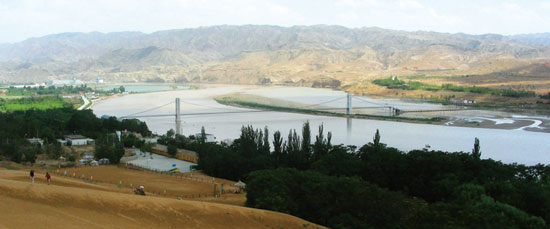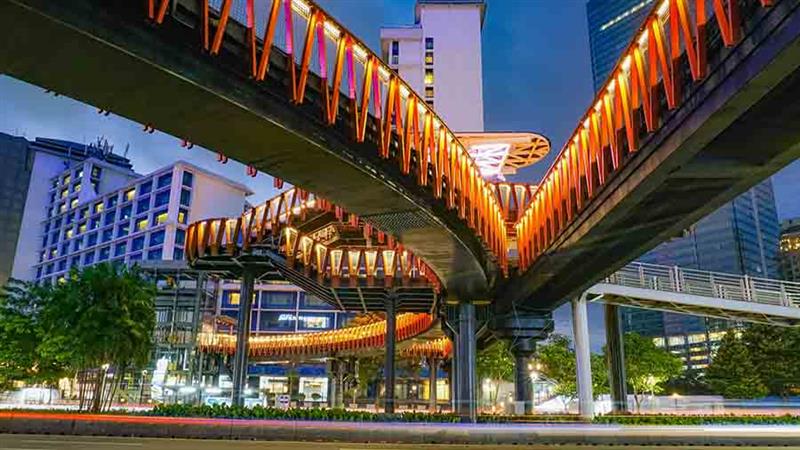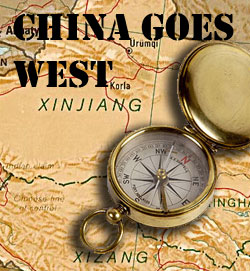Ningxia: Small but Beautiful and Productive

Aug. 19 – Running around China to see what opportunities there are has long been part of what our firm regularly does in order to keep abreast of new developments and to understand the country as a whole. It’s also a lot of fun; China often seems more a kaleidoscope of different images than of one particular stereotype. And the key to being able to provide a quality service, especially in foreign investment, is to try and understand what is really going on out there. It’s not possible to properly advise clients or give data on potential investment opportunities without this. China extends far beyond the main cities of Beijing, Shanghai and Guangzhou and it’s a lesson we learned a long time ago. We have serviced clients in our 18 years of practice in China from every single province and autonomous region, many located in the second and now third tier cities.
When it comes to Ningxia, I am always reminded of the fact that it is one of China’s smallest regions at just 66,400 square kilometers, yet it reaped one of our largest clients – a US$400 million investment in city center real estate development in the capital city of Yinchuan. Accordingly, I’ve always had a soft spot for the area. Ningxia is also a little different from anywhere else in China. It’s the only Hui minority autonomous region. The Hui are Muslims originally descended from Arabs and Persians; traders that arrived and then settled during the Silk Road era over 1,000 years ago. Although, like all Muslims, they don’t eat pork, they have assimilated parts of Han Chinese culture into their lives, including their variation of Chinese Islamic cuisine and Muslim Chinese martial arts. Their mode of dress also differs primarily in that men wear white caps and women wear headscarves or (occasionally) veils, as is the case in most Islamic cultures. They are more liberal when it comes to alcohol – and Ningxia wheat beer is both a potent and delicious brew (there’s an opportunity for someone wanting to get real ale into Chinese markets).
Ningxia as a whole is quite poor compared to its provincial neighbors and it struggles with infrastructure and water shortages. It does have abundant natural resources however, particularly coal and natural gas. Tourism is also beginning to generate some impetus and despite the wide-spread arid land, agriculture is still relatively important. Irrigation from the Yellow River here provides reasonable crops, despite much of the region being desert.
The local government is among the most progressive in China and, despite the difficulties with the terrain, has invested wisely in infrastructure. Billions of yuan has been invested in highway construction, bringing Ningxia’s total highway grade length in the region to 12,456 kilometers, a fairly high proportion compared with other provinces. All of Ningxia’s cities, towns, mining centers and the majority of villages have vehicular access. Inter-provincial highways now also connect Yinchuan directly with Xi’an and Wuhan and provide a north-south connection between other routes in the national trunk highway system. Rail transit in and out of the province was improved considerably by the construction of the Baotou-Lanzhou line which enters the region from the western-most point and leaves in the north. Other national lines are the Baoji-Zhongwei line, which is part of the Eurasia Land Bridge, and the Pingluo-Rujigou line which is crucial for transporting coal to neighboring provinces.
The two airports in Ningxia both serve Yinchuan. Hedong Airport flies to destinations across China. In July 2007, the airport began operating direct flights to Hong Kong twice a week, while there are some cargo routes open with Russian and various Central Asian countries. Helanshan Airport is used predominantly by the military, but it serves civilian domestic routes as well. Ningxia gained its own airline, Ningxia Airlines, last year – a joint venture with Shenzhen Airlines – and this is now operational and connects with several other western cities as well as to Shenzhen in the south. Investment into Ningxia has accordingly increased from both Hong Kong and Guangdong Province as a result. The local government is looking to develop Ningxia as a regional aviation transportation hub, and especially for cargo and maintenance. A further two airports, to be located at Guyuan and Zhongwei are in the pipeline.
While the Yellow River runs through Ningxia, it is too shallow to transport large amounts of goods. There is some short distance water traffic transporting smaller quantities of cargo, though the river tends to freeze over completely in mid-winter and this limits the amount of traffic accessible through the waterway.
Ningxia has been booming in fact for quite some time. The region’s GDP increased by 12.4 percent to reach RMB83.42 billion in 2007 and has since posted growth of 11 percent and 12 percent in 2008 and 2009, respectively. According to China Daily, Ningxia’s GDP growth has exceeded the national average for 11 consecutive years. The main industries in the region are coal, pharmaceuticals, electricity, and metallurgy. The region has proven coal reserves of 31 billion tons, with estimated reserves of 202.7 billion tons and the yearly output is approximately 25 million tons. A RMB100 billion project to build Asia’s largest liquefied-coal base is currently underway. The projects will build chemical plants which can convert coal into fuel additives such as dimethyl ether, olefin, and methanol. Plants which by 2020 will be able to convert 50 million tons of coal into 10 million tons of diesel annually are also under construction.
Other natural resources include natural gas and wind power. Ningxia has proven 27 million tons of petroleum reserves and natural gas reserves amounting to 110 million cubic meters in the Shaanxi-Gansu-Ningxia basin. Ningxia is also the national leader in wind power development. The Helanshan Wind Farm and Ningxia Tianjing Shenzhou Wind Power Project are recognized by the UN as the largest Clean Development Mechanism projects in China. Between the two projects, they aim to reduce CO2 emissions by around 222,000 tons per year. Both receive investment from the UK. The chemical industry of natural gas is also developing rapidly and is gradually forming a new backbone industry in Ningxia. Products such as tantalum, niobium, and beryllium rank third nationally.
The region’s farmland area is the fourth largest in China and has one of the 10 biggest pasture areas in the country. Despite the threat of desertification in some areas, agriculture is still an important part of the local economy, especially in northern areas where the Yellow River passes through the region. The north of the province is considered the granary of the northwest, and rice, millet, and other grains are abundant. Ningxia also produces half of the world’s cashmere. Tourism is also a potential growth industry, and the combination of a rich and diverse cultural history and striking natural scenery is attracting increasing numbers of visitors. Tourism has seen noteworthy growth in the past few years, and the local authorities are keen to promote further developments. There are mausoleums of the Xixia Dynasty (1038- 1227) and rock paintings from ancient times on the eastern side of the Helan Mountains. Genghis Khan himself died here, after being mortally wounded in a battle with the local Xia tribe. His body was carried back secretly to be buried in Mongolia, while the combination of the desert settings, Yellow River and spectacular sand dunes and red cliffs make Ningxia a favorite for filming Chinese historical epics.
In terms of investment, there is a state-level development zone in Yinchuan. The Yinchuan Economic and Technical Development Zone was established in July 1991 and covers over 7.5 square kilometers of land. The industrial structure of the YETDZ consists of two parts, the first of which occupies an area of 2.26 square kilometers and has established key industries relating to special medicine production, mechanical and electronic integration, and information services. The second part covers an area of 5.24 square kilometers and has four industrial parks, with the central one designated for finance, commerce, agency services and entertainment. Like all of China’s designated western regions, Ningxia enjoys preferential tax policies and can offer investment incentives to foreign investors that are not available in the eastern cities. Again, in common with the Western regions, wage levels and factory costs are far lower than in the first tier cities, with a minimum monthly wages of RMB710 a month for semi-skilled workers. Factory space is about 30 percent of that in Shanghai. Being fairly dry, Yinchuan has also attracted a fair amount of high-tech industry, including the manufacturing of sensitive component parts in the IT industry. There is a disproportionate amount of both Japanese and South Korean investment here, capitalizing on the relative security, good infrastructure, investor friendly and forward looking government, tied in with a combination of low costs. It’s a winning combination, and with a flight time of just one hour and 40 minutes from Yinchuan to Beijing, Ningxia’s good value is closer to Beijing than Shanghai. In terms of value for money, coupled with central access to China’s inland markets, Ningxia may be small, but it is highly productive.
Chris Devonshire-Ellis is the principal and founding partner of Dezan Shira & Associates. The firm has 18 years of foreign investment experience throughout China, including Ningxia. For assistance and advice over laws, taxes and incentives for foreign investment in Ningxia please contact the firm at info@dezshira.com.
Chris also contributes to India Briefing , Vietnam Briefing , Asia Briefing and 2point6billion
Related Reading
The Complete “China Goes West” Series
Going West
(Includes complimentary back issues of Western Region themed editions of China Briefing Magazine)
Yinchuan City Guide
(Complimentary download)
Business Guide to West China
(Includes Gansu, Guizhou, Ningxia, Qinghai, Shaanxi, Sichuan, Tibet, Yunnan and Xinjiang)
- Previous Article India Business Forum Building Strategic Relationship with China
- Next Article China’s Central Bank May Allow Further Foreign Investment in Local Markets





























